- My Favorite Book of the Year
- The Year’s Biggest Disappointment
- Fiction
- Nonfiction
- Reprints
- Books I Missed from Last Year
- Looking Forward
Welcome to the latest installment of my annual overview of the previous year’s Bedlam Files-friendly publications. Of the publishing news in 2021 there’s really not much worth reporting; I view the year as, essentially, the inevitable hangover that followed the once-in-a-century upheavals of 2020. That said, there were some interesting books appearing in ’21, starting with…
My Favorite Book of the Year
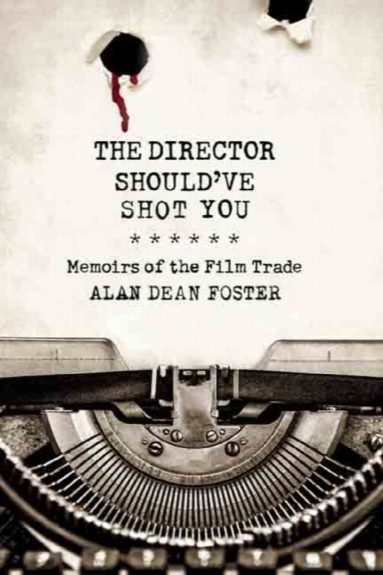 THE DIRECTOR SHOULD’VE SHOT YOU is a Centipede Press published remembrance by ALAN DEAN FOSTER of his years writing movie novelizations. Foster was and is one of the most prolific movie novelizers in the business—with science fiction being his specialty—making this the foremost book on the subject.
THE DIRECTOR SHOULD’VE SHOT YOU is a Centipede Press published remembrance by ALAN DEAN FOSTER of his years writing movie novelizations. Foster was and is one of the most prolific movie novelizers in the business—with science fiction being his specialty—making this the foremost book on the subject.
Foster’s outspoken nature has made him something of a controversial figure in Hollywood. It got him into big trouble on a couple of his assignments, ALIEN 3 and THE CHRONICLES OF RIDDICK, the latter of which inspired a dressing-down by a studio lackey after Foster dared point out the script’s flaws to the film’s star Vin Diesel. Foster also has a tendency to grow frustrated at the scientific inaccuracies of the scripts he’s tasked with novelizing, upsetting filmmakers who don’t take kindly to him “fixing” their stories.
Foster puts all this down in easygoing prose that, the frequent nerdy puns aside (an inevitability, it seems, in sci fi themed nonfiction), is quite readable. The design and layout, as we’ve come to expect from Centipede Press, are impeccable, with crisp reproductions of book covers, letters and other goodies. A must!
The Year’s Biggest Disappointment
That designation goes to THE BEAUTY OF LIVING TWICE by SHARON STONE (Knopf). Ms. Stone has led a varied and exciting life without question, and an honest accounting of that life would doubtless have made for quite a book, but THE BEAUTY OF LIVING TWICE isn’t it. In place of the brashness that Stone puts forth in interviews (and, I’ve been told, her on-set interactions), we get a lot of treacly proclamations about forgiveness, inclusivity and the glories of sisterhood, all clearly designed to appeal to the woke crowd.
Covered is Stone’s impoverished childhood in Meadville, Pennsylvania, which was marked by sexual abuse, and her early years in Hollywood, in which Stone appeared in several forgettable movies, with her big break occurring in BASIC INSTINCT (1992). Of her iconic leg cross in that film Stone acknowledges there are a lot of competing stories about its filming, but assures us they’re all “bullshit”—okay, but most of that bullshit was floated by Stone herself, who over the years has proffered quite a few diverging accounts. She also writes about her “close friendships” with the hugging saint Mātā Amritānandamayī and the Dalai Lama, even though the latter’s sole public statement about Sharon Stone has been “Yes, I have met that woman.”
I have further doubts about Stone’s claim that an unnamed director demanded she sit on his lap, with her description of the incident being extremely vague. Likewise her account of losing custody of her adopted son, with her overview of the case being, once again, quite vague. Perhaps that means she isn’t telling the truth about her experiences, or perhaps she is. This book, in any event, is a clunker.
Fiction
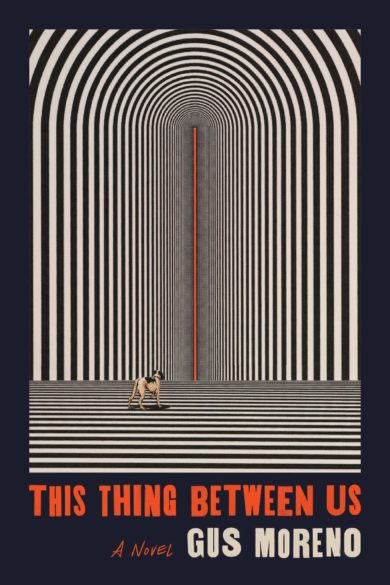 The official synopsis for THIS THING BETWEEN US (Farrar, Straus & Giroux) by GUS MORENO is somewhat misleading, describing a story in which “A widower battles grief, rage and the mysterious evil inhabiting his home smart speaker.” The first part of that statement is an accurate description of the novel, but the second constitutes only a portion of the whole.
The official synopsis for THIS THING BETWEEN US (Farrar, Straus & Giroux) by GUS MORENO is somewhat misleading, describing a story in which “A widower battles grief, rage and the mysterious evil inhabiting his home smart speaker.” The first part of that statement is an accurate description of the novel, but the second constitutes only a portion of the whole.
It begins with the narrator Thiago, a working-class Chicagoan, at the funeral of his recently deceased wife Vera. The horrors-of-modern-technology angle delineated by the synopsis is provided by Itza, a smart speaker synched to the devices in Thiago’s condo. It quickly becomes apparent that Itza is haunted and/or possessed when the device begins ordering errant packages and playing odd songs. Following Vera’s death at the hands of a gangbanger, Itza begins “malfunctioning” in a most disturbing manner, leading Thiago to destroy the device.
Thiago then relocates to a cabin in Colorado, setting up a PET SEMATERY-esque angle at odds with the grief-centered horror of what came before. But in the book’s final third things take an entirely different turn, one in which hallucination and “reality” increasingly overlap amid a David Searcy-meets Stephen King-meets Philip K. Dick aesthetic. Not everyone will appreciate the approach, but I say it makes for an invigorating reading experience.
OUR LADY OF THE TURKS (Contra Mundum) is the premiere English translation of the only novel by Italy’s late CARMELO BENE. It’s a work that can be read as surrealist literature, an eccentric autobiography or an especially trenchant satire. In fact it’s all those things, with, in the words of translator Carole Viers-Andronico, “no explanations given, nor any elucidation provided. There are only black holes.”
The ostensible subject is the 1480 invasion of Otranto, Italy by the Ottomans. The invasion, as presented here, is metaphoric, consisting of Turkish sightseers who amid a succession of parades and fireworks displays annoy the protagonist, an already tortured Otranto resident, to no end. Equally intrusive is the title character, a spectral woman known as Saint Margherita who serves as both a domestic companion and an object of unattainable fantasy.
Translating this crazed masterwork was, as Viers-Andronico admits, no easy task. Utilized is unconventional and often jarring syntax, with frequent use made of the “&” symbol. Precisely how close Viers-Andronico’s verbiage is to the Italian language original I have no idea, but Bene’s peculiar genius shines through.
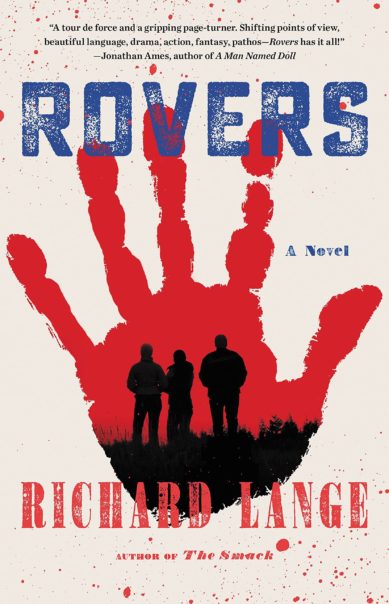 Switching gears, we arrive at ROVERS (Mulholland Books) by RICHARD LANGE. A vampire novel, it’s much like NEAR DARK in conception and execution, tracking a grungy band of nomadic bloodsuckers through a parched landscape in an action-oriented odyssey that’s equal parts Bram Stoker and Sam Peckinpah.
Switching gears, we arrive at ROVERS (Mulholland Books) by RICHARD LANGE. A vampire novel, it’s much like NEAR DARK in conception and execution, tracking a grungy band of nomadic bloodsuckers through a parched landscape in an action-oriented odyssey that’s equal parts Bram Stoker and Sam Peckinpah.
It takes place in 1976, with nomadic vampire “Rovers” traversing the American west in an odyssey that concludes, quite bloodily, in Las Vegas. The prose is appropriately tough and hard-bitten, the violence quite relentless and the characters much better drawn than those of most vampire novels. On the downside are some needlessly distracting stylistic choices and an obnoxiously open-ended conclusion. Regarding the latter, it’s possible, in the curiously unsettled state in which he leaves many of his characters, that the author was anticipating a sequel. Fine, but until it arrives we’re stuck with a book that ends quite awkwardly.
I’m not sure anyone was calling for a post-9/11 throwback to the airplane thrillers of old, but here it is. FALLING (Avid Reader Press) is an unabashedly commercial airplane-set suspensor, written by ex-flight attendant T.J. NEWMAN.
The protagonist is Bill, a So Cal pilot who as the novel opens boards a flight to New York. Shortly after taking off he receives a facetime call from a guy who’s taken Bill’s wife and two children hostage. The intruder’s demand: poison all the passengers and then crash the plane. If Bill elects not to follow those instructions the man will kill the hostages.
I’ll keep mum on precisely what transpires, outside the fact that it involves a big-hearted flight attendant, a determined FBI agent and a strategically placed terrorist mole on the plane. It’s extremely well-orchestrated, with the author’s insider knowledge of all things aerial shining through in the many telling details, and in frankly worded passages like this one: “a flight is just a random sample of the general population, a classic bell curve. A few assholes and a few exemplars, but primarily, a whole bunch of sheep.”
CHASING THE BOOGEYMAN (Gallery Books) was the first solo novel by Cemetery Dance editor (and frequent Stephen King collaborator) RICHARD CHIZMAR. A wholly unique account of crime and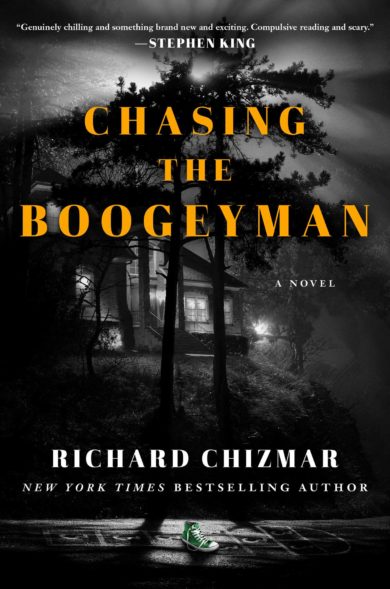 detection, it blends autobiographical and thriller elements into a mostly harmonious whole.
detection, it blends autobiographical and thriller elements into a mostly harmonious whole.
The book’s setting, and true main character, is the author’s hometown of Edgewood, Maryland, where, according to this book, a serial killer was active during the summer and autumn of 1988. That was also an important time in Chizmar’s life, as he, at age 22, had just finished college and moved back home with his parents, in order to put together the first issue of Cemetery Dance and, in early ‘89, marry his high school sweetheart.
Chizmar may lather on the small town nostalgia a bit thickly, with nearly every page containing a misty-eyed childhood remembrance. Still, it’s that mixture of autobiographical sincerity and “true” crime trappings that render this book unique, with the minutiae of life in Edgewood past and present rubbing up against a depiction of psychotic insanity that’s never less that fully engrossing. Think IN COLD BLOOD meets DANDELION WINE, a mixture that somehow works.
ONCE UPON A TIME IN HOLLYWOOD (Harper), the premiere work of prose fiction by QUENTIN TARANTINO, is in many respects just like that talented man’s films: unique, unpredictable, outrageous and profane. It’s also, I’m afraid, not entirely satisfying.
The book, a novelization of Tarantino’s 2019 flick of the same name, takes place in the final year of the 1960s. It was then that the Hollywood studio system was being usurped, foreign films were having a renaissance on American screens and a certain “family,” led by a failed musician named Charles Manson, was afoot in LA. All those things are covered in these pages, in which fiction is mixed quite audaciously with lengthy dissertations on movies, music and celebrity, related in a narrative voice that’s nobody’s idea of refined and chronology that’s anything but linear. As such the book is quite likeable, and even compelling in its own resolutely nontraditional manner.
But as I mentioned above, it’s not entirely satisfying. The violent ending we saw onscreen was largely jettisoned, and is greatly missed. Another complaint I have is with Tarantino’s descriptions of the filming of a TV pilot, which are presented as actual occurrences. The idea might have been for these passages to playfully intersect with the “real” action, or possibly they exist as some ironic commentary on the Hollywood milieu in which the book takes place. Either way, though, the effect doesn’t work.
Nonfiction
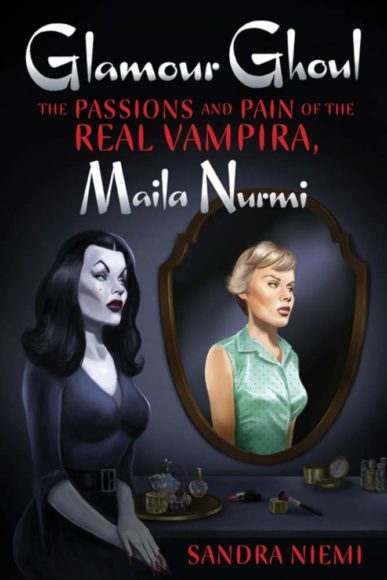
GLAMOUR GHOUL: THE PASSIONS AND PAIN OF THE REAL VAMPIRA, MAILA NURMI (Feral House) isn’t the first book about the late Ms. Nurmi (1922-2008), but it is very likely the best. Written by Nurmi’s niece SANDRA NIEMI, GLAMOUR GHOUL functions as both a straightforward biography and a personal memoir, and works equally well as both.
Its chief biographical source is a cache of elegantly written recollections by Nurmi, uncovered by the author while cleaning out her aunt’s home. Those recollections are extensively quoted, and supplemented by autobiographical recountings by Niemi.
Covered is Maila Nurmi’s upbringing in Astoria, OR, where she spent her teenage years working in a fishing cannery (as did Niemi). She relocated to Hollywood, where she experienced much sexual harassment, and relationships with Marlon Brando, James Dean and Anthony Perkins before becoming Vampira, the world’s first TV horror hostess. That the program didn’t last as long as it might have was due to Nurmi’s surly and mistrustful nature, and also the fact that her bosses were assholes (proving that not much has changed in Hollywood from then to now). After that her career bottomed out for good.
The closest thing this book has to an overriding villain is Cassandra Peterson, a.k.a. Elvira, who’s portrayed as a talentless bimbo who blithely copied Vampira’s act. For a different take on Ms. Peterson see…
YOURS CRUELLY, ELVIRA: MEMOIRS OF THE MISTRESS OF THE DARK (Hatchett Book Group), an autobiography by the now-70 year old CASSANDRA PETERSON. Elvira, she claims, wasn’t something she planned for, nor initially took too seriously. Peterson, at age thirty, was simply looking for acting work, and turned up at a 1981 audition being held by a Los Angeles TV station with an extensive B-movie library. Nobody was prepared for how famous the character would become, with a slew of public appearances and endorsements that were lucrative enough to buy Peterson a Hollywood Hills mansion and allow her to self-finance a movie.
The above encompasses the second half of YOURS CRUELLY, ELVIRA. The first half recounts Peterson’s earlier years, which commenced with an authentically horrific incident: a severe scalding as a toddler, which required extensive skin grafts and has resulted, Peterson claims, in an insatiable drive that carried her through the many dark portions of her life.
This book, in summation, is a good one. As a tell-all it satisfies, naming names and dishing out enough dirt to fill a cemetery while revealing, in no-nonsense prose, the inner world of the woman behind a character we’ve all come to know and love.
MY ADVENTURE WITH SHEENA, QUEEN OF THE JUNGLE: THE MAKING OF THE MOVIE SHEENA (BearManor Media), consisting of diary entries by YORAM BEN-AMI offers further proof that even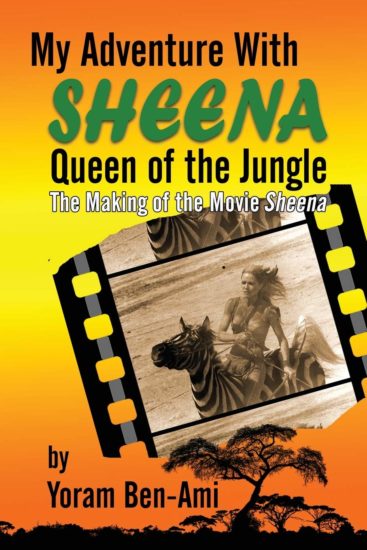 the lousiest movies have interesting histories. Lousy is indeed the word for 1984’s SHEENA, a mega-budgeted Columbia Pictures backed take on the comic book character Sheena, a white girl raised by animals who somehow becomes the queen of the jungle.
the lousiest movies have interesting histories. Lousy is indeed the word for 1984’s SHEENA, a mega-budgeted Columbia Pictures backed take on the comic book character Sheena, a white girl raised by animals who somehow becomes the queen of the jungle.
The Israeli born Ben-Ami was given the unenviable task of producing this mess. The director was the late John Guillermin, who was known for his headstrong and uncompromising approach. On SHEENA Guillermin got his long-awaited comeuppance in the form of a personal tragedy that occurred midway through the shoot, after which, according to Ben-Ami, “I could see he would never be the same again.” Of the late Tanya Roberts, who headlined the film, we get very little info outside the obvious: that she made for pleasant company and was mighty easy on the eyes.
The most upsetting stage of the production was SHEENA’S eventual premiere, which, needless to say, wasn’t well received at all. Ben-Ami consoles himself with the words “The critics had no way of knowing—nor should it have mattered to them—the immense challenges we had in bringing SHEENA to the screen. But we knew.” And now so do we.
SHOOTING MIDNIGHT COWBOY (Farrar, Straus and Giroux) by GLENN FRANKEL relates the making of a far more resonant piece of cinema: MIDNIGHT COWBOY, one of the greatest of the “New Hollywood” films that appeared in the late 1960s and early 70s. The film represented career highlights for its late director John Schlesinger, its screenwriter Waldo Salt and James Leo Herlihy, who authored the 1965 source novel, as well as its stars Jon Voigt and Dustin Hoffman. Such a conglomeration of receptive talent is rare, as is the fact that these men were allowed the latitude to create such an endearing and uncompromising piece of work.
Several long-standing myths about MIDNIGHT COWBOY are shattered in these pages. Hoffman’s iconic taxi thumping, for instance, is widely claimed to have been an unscripted encounter, when in fact the dialogue Hoffman utters (“I’m walkin’ here!”) was the scene’s sole instance of improvisation. Another example: the claim that the film’s X rating was repealed after the filmmakers pressured the MPAA, when in fact the initial rating was an R, with the X utilized solely as a publicity scheme.
Controversy was something United Artists had to drum up given that the details of MIDNIGHT COWBOY’S shoot, as recounted here, were pretty uneventful. Likewise the reception, which was largely positive, and culminated with a most unexpected, but entirely deserved, Best Picture Oscar win.
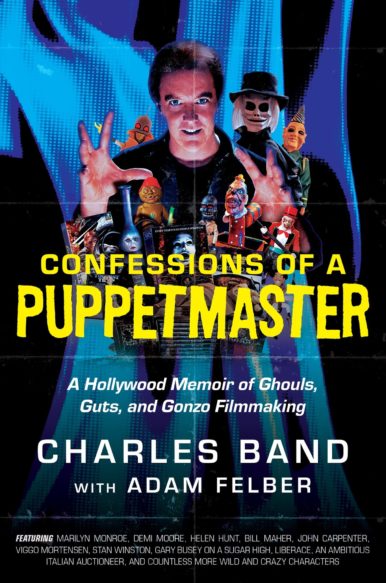 CONFESSIONS OF A PUPPET MASTER (William Morrow), a long-in-coming memoir by the veteran schlockmeister CHARLES BAND (in collaboration with ADAM FELBER), confirms an impression I’ve long had about Mr. Band: that he’s a hyperactive teenager at heart. Recounted in these pages is a wild existence that started in Italy, where Band’s first brush with filmmaking was as a child actor, employed by his filmmaker father Richard Band. Another formative experience was a nightmarish stay in a third world hospital due to appendicitis, where Band learned that “I could live through absolutely anything.”
CONFESSIONS OF A PUPPET MASTER (William Morrow), a long-in-coming memoir by the veteran schlockmeister CHARLES BAND (in collaboration with ADAM FELBER), confirms an impression I’ve long had about Mr. Band: that he’s a hyperactive teenager at heart. Recounted in these pages is a wild existence that started in Italy, where Band’s first brush with filmmaking was as a child actor, employed by his filmmaker father Richard Band. Another formative experience was a nightmarish stay in a third world hospital due to appendicitis, where Band learned that “I could live through absolutely anything.”
His later endeavors included the formation of the pioneering video cassette outfits Meda (later Media) and Wizard Video, and the production of flicks like THE EYES OF DR. CHENEY and CRASH. This led to Band becoming a most unlikely mogul, founding Empire Pictures in 1983 (and dissolving it six years later), followed by the inception of Full Moon and a seemingly never-ending string of grade-Z epics.
Band’s instincts as an entertainer are in full evidence throughout CONFESSIONS OF A PUPPETMASTER. It helps, of course, that he’s led such an eventful existence, and that his youthful exuberance is so genuine, resulting in a book that’s wilder, more outrageous and much better than most of his movies.
BIG BAD JOHN: THE JOHN MILIUS INTERVIEWS (Bear Manor Media) is a book of interviews, conducted by NAT SEGALOFF, with one of Hollywood’s more infamous screenwriter/directors. A Jewish intellectual who feels the need to maintain, and constantly remind us of, a hyper-macho orientation, Milius is an enormously entertaining and refreshingly nonconformist individual. He’s also a writer whose talents are undeniable.
Covered in these interviews are Milius’ privileged upbringing in Malibu, CA (a far cry from the backgrounds of the outlaws, mountain men, soldiers and barbarians that populate his screenplays), during which he cultivated a lifelong love of surfing. He also speaks about attending film school in the late 1960s with a peer group that included Francis Ford Coppola, Steven Spielberg and George Lucas.
Milius’ celebrated scripts for THE LIFE AND TIMES OF JUDGE ROY BEAN, JEREMIAH JOHNSON and APOCALYPSE NOW were all heavily retooled, and his autobiographical surfing epic BIG WEDNESDAY was a notorious flop. His subsequent directorial assignments have been few and far between, with his major source of income coming from uncredited rewrites on movies like DIRTY HARRY, JAWS and THE HUNT FOR RED OCTOBER.
An afterword informs us that in the years since the bulk of these interviews were conducted (the last was in 2001) Milius’ fortunes declined precipitously. A debilitating 2010 stroke means it’s doubtful he’ll be making any more movies, and he certainly won’t be giving too many more interviews. It’s a good thing, then, that BIG BAD JOHN exists.
DANGEROUS VISIONS AND NEW WORLDS: RADICAL SCIENCE FICTION, 1950-1985 (PM Press) is a collection of reader-friendly essays edited by ANDREW NETTE and IAIN McINTYRE. The subject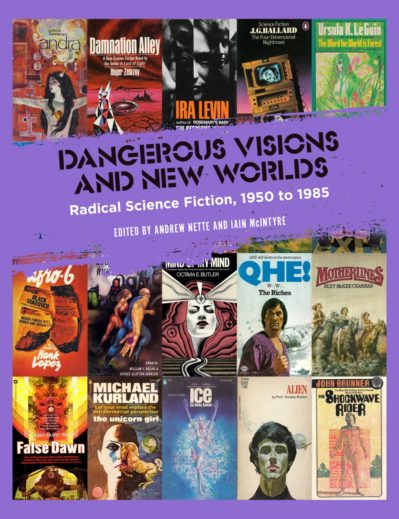 is science fiction literature of the latter half of the Twentieth Century, when the UK’s New Worlds magazine and the Harlan Ellison edited anthology DANGEROUS VISIONS led the charge in a radical restructuring of what was up until then a fairly hidebound genre.
is science fiction literature of the latter half of the Twentieth Century, when the UK’s New Worlds magazine and the Harlan Ellison edited anthology DANGEROUS VISIONS led the charge in a radical restructuring of what was up until then a fairly hidebound genre.
Standout essays include a piece by Donna Glee Williams, who contrasts Robert Heinlein’s THE MOON IS A HARSH MISTRESS, a lunar-set hymn to rugged individualism, with Ursula K. Le Guin’s similarly oriented but far more liberal minded THE DISPOSSESSED. There’s also a good write-up on the late smut book outfit Essex House by Rebecca Baumann (who gets extra points for extensively referencing an article I wrote on the subject), and an equally fine Kelly Roberts authored take on Roger Zelazney’s DAMNATION ALLEY. I also appreciated Maitland McDonagh’s essay on sci fi themed gay smut novels of the late 1960s and 70s, the existence of which I was completely unaware.
Among the other essays are one on author Alice Sheldon (a.k.a. “James Tiptree Jr.”), a piece on apocalyptic YA novels, an overview of the pioneering feminist science fiction of Judith Merrill and a look at the 1969 insurrection fantasy AFRO-6. What’s missing from this otherwise admirably exhaustive compilation is coverage of non-English speaking authors like France’s Gerard Klein and Austria’s Herbert W. Franke, although there is a good overview of the work of Russia’s Strugatsky brothers, so on the international front DANGEROUS VISIONS AND NEW WORLDS isn’t entirely lacking.
The conception, filming and reception of the 2004 British zombie comedy SHAUN OF THE DEAD are covered with admirable thoroughness in YOU’VE GOT RED ON YOU: HOW SHAUN OF THE DEAD WAS BROUGHT TO LIFE (1984 Publishing). Author CLARK COLLIS does about as good a job as can be expected, answering every conceivable question you might have about the film.
Virtually everyone who worked on SHAUN OF THE DEAD is heard from, including director Edgar Wright, co-writer/star Simon Pegg and cinematographer David M. Dunlap (whose fraught relationship with Wright provided the shoot’s only real tension). The finished film wasn’t the massive hit everyone was predicting, but, bolstered by enthusiastic blurbs from George Romero, Peter Jackson and Quentin Tarantino, it did well. I think Collis overstates SHAUN’S subsequent impact, which if this book is to be believed is akin to that of NIGHT OF THE LIVING DEAD, but it has become iconic among horror buffs, being one of the screen’s most successful meldings of horror and hilarity.
Reprints
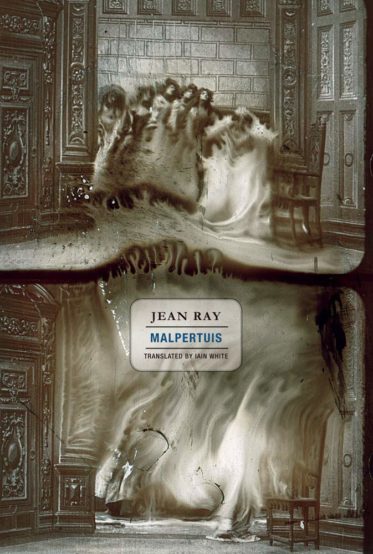
JEAN RAY’s 1943 Belgian masterpiece MALPERTUIS, which appeared in 2021 in a new edition by Wakefield Press, is one of the most mind-boggling horror novels ever written. Presented in the same Iain White translation that graced the previous Atlas Press edition, it’s an insanely complex, minutely detailed, wildly surreal piece of work. Utilizing several seemingly disparate plot strands, it tells the story of Malpertuis, an accused mansion that houses some deeply unusual folk who spend their days bickering, playing games and finding themselves beset by all manner of inexplicable phenomena.
That’s but a portion of this novel, which also contains a secluded island inhabited by giant statues, a deranged sorcerer, an inquisitive priest and a werewolf, all set down in Ray’s wildly dreamlike yet curiously logical, meticulous prose. In direct contrast to most fantasy authors, Ray effectively constructs an atmosphere of deceptive routine and normality, which renders the supernatural business all the more startling.
The 1966 French-Canadian novel SWALLOWED (Esplanade Books) by REJEAN DUCHARME (initially published as THE SWALLOWER SWALLOWED) is the psychotic inverse of THE CATCHER IN THE RYE: an unsparing first-person account of adolescent upset and dissatisfaction.
The narrator is Bernice Einberg, a precocious and severely introverted brat living on an island in Quebec. Her father is a Jew and her mother a Catholic, a dichotomy that contributes, in part, to Bernice’s schizophrenic mindset, in which fantasy is juxtaposed with reality in a manner that makes it difficult if not impossible to discern where one state leaves off and the other begins. After poisoning her hated mother’s pet cat, and beating to death its replacement, Bernice is sent by her fed-up father to stay with a relative in New York and, following further bouts of troublemaking, exiled to Israel.
Not to spoil anything, but there are no lessons learned in the course of this book. Bernice does not ditch her antisocial ways and become a nice person, with the book concluding in just the opposite fashion. The grown-up presence that pervades most every teen-centered narrative ever written, on hand to impart a mature wisdom to which the protagonist inevitably catches on, is nowhere to be found in THE SWALLOWER SWALLOWED, making it one of the very few novels that can truly be said to capture the pains of adolescence.
DARK GODS hails from 1985. Appearing in a new edition from PS Publishing, it contains four stories by T.E.D. KLEIN, the brilliant but extremely unprolific author of THE CEREMONIES. DARK GODS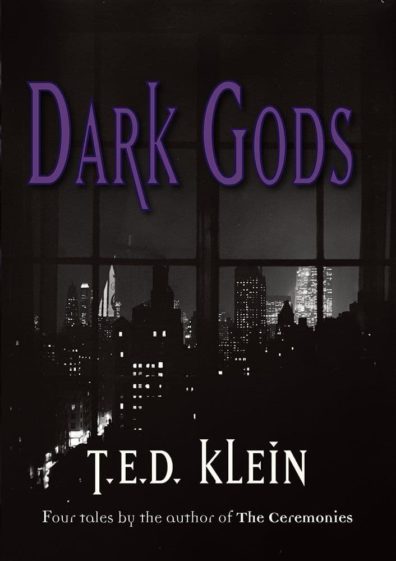 showcases Klein’s knack for literary horror, and provides a tantalizing glimpse of what might have been had he kept at it.
showcases Klein’s knack for literary horror, and provides a tantalizing glimpse of what might have been had he kept at it.
It begins with “Children of the Kingdom”, an award-winning account of a young man’s relationship with his ailing father, and what happens when the latter hears from an acquaintance that life on Earth is descended from a race of horrific creatures, some of which are still at large. “Petey” is about a demonic entity lurking at a country house one night when the story’s clueless protagonist is having a housewarming party. “Black Man With A Horn” is a sophisticated tribute to H.P. Lovecraft, with a narrator who happens to have been a colleague of the great man finding himself stuck in a very Lovecraftian situation involving a ghostly harbinger of death. The final story is in my view the highlight of the collection: “Nadelman’s God”, a creepy and absorbing narrative about a horrific poem the stuffy protagonist writes in his college days that years later inspires a misguided young man to invoke a malignant deity by following the text’s guidelines.
Appearing in 2021 in a limited edition hardcover from Centipede Press was the British adults-only classic THE GAS by CHARLES PLATT. An incomparably vile relic from the golden age of smut fiction, it’s about a yellowish contagion accidentally released from a government laboratory that causes people to lose their inhibitions, with mass orgies, a specially designed sex machine, parachuting lovers and other wackiness gradually giving way to unbelievable violence and perversion as the British populace’s darker impulses rise to the fore.
This edition features newly written introductions by Platt and Ramsey Campbell, as well as an essay by Philip Jose Farmer that appeared in the 1980 Savoy Books edition. Unfortunately the text was revised from the book’s initial versions, with Platt making the story’s satirical bent more overt—and, I feel, lessening the impact of a novel that, in its crudity and outrageousness, is very likely the last word in extreme erotica.
Incidentally, I’m still waiting for someone to reprint Platt’s equally potent 1970s smut novels THE POWER AND THE PAIN and SWEET EVIL…
One of the most agreeable developments surrounding the release of Guillermo Del Toro’s latest film (a box office flop) is NYRB Books’ 2021 reprint of the 1946 source novel: NIGHTMARE ALLEY by the late WILLIAM LINDSAY GRESHAM, which remains one of literature’s most enduring portrayals of the dark side of the American Dream.
It pivots on Stanton Carlisle, an ambitious young man who joins a carnival. There, amid geeks, freaks and hooligans of every conceivable persuasion, Stan discovers a talent for grift that leads to him becoming an extremely well paid spiritualist.
That Stan is eventually done in by this charade is hardly a surprise given all the foreshadowing the author provides, such as the chapter headings, which are named after tarot cards, and come complete with symbolic definitions (such as “Resurrection of the Dead,” defined thusly: “By the call of an angel with fiery wings, graves open, coffins burst, and the dead are naked”). This guy’s minutely described spiral into alcoholism and homelessness is an agonizingly prolonged one, with a final humiliation that can be viewed as either the ultimate nihilistic flourish or an act of bloody redemption.
Books I Missed From Last Year
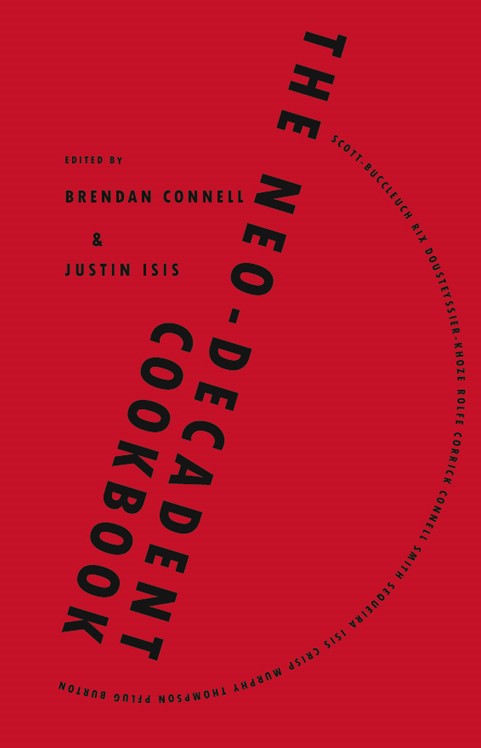
The neo-decadent literary movement is well represented by THE NEO-DECADENT COOKBOOK (Eibonvale), edited By BRENDAN CONNELL and JUSTIN ISIS, an anthology that purports to be a cookbook. In actuality only the second-to-last offering, “Nettle Tea” by Ursula Pfiug, which provides more-or-less straightforward instructions on how to concoct that delicacy, conforms to the strictures of a true cooking manual. The rest of the book stands as a potent sampling of neo-decadent preoccupations, with a focus on foodstuffs both real and imaginary; as the back cover inquires, “Have you ever sautéed geometrical sex or eaten fate from the breasts of Minerva?”
Unfiltered surrealism is a constant (it’s not for nothing that a character in one story is named Nadja), as is a type of poetic dissonance that may be unique to the Neo-Decadents (“Usurp the tongue as arbiter of choice:/overrule distaste and/IGNORE the bias of affinity”). The contributors include Eibonvale’s head David Rix, as well as Douglas Thompson, Quentin S. Crisp and the editors themselves.
Of course you don’t need to have any interest in Neo-Decadence to enjoy this book, which is ideal for anyone interested in wild and plain nutty fiction. Plus it’s quite short, running a fast 168 pages that can be easily devoured in an hour or two.
BOTTOMFEEDER is a stand-out graphic novel from Eibon Press and the team of scripter STEPHEN ROMANO and artist PAT CARBAJAL. Its basis was a Romano penned screenplay that, when the financing for the proposed movie failed to materialize, was adapted into a three issue comic book series that in 2020 was released as a graphic novel.
The pitch for this twisted tale was “BAD LIEUTENANT meets HUMANOIDS FROM THE DEEP,” an entirely accurate summation. The protagonist is the ironically monikered Joe Angel, a heroin-addicted police commissioner stationed in the seaside burg of San Lucifer. Here toxic waste has led to an invasion of mutant crayfish with a taste for human flesh—critters whose creation, as Angel’s investigation uncovers, was not entirely accidental.
The late actor Joe Pilato, who was meant to headline the BOTTOMFEEDER movie, provides the features of Joe Angel, while other characters are “played” by the B-movie legends Zoe Tamerlis, Clu Gulager and Bill Moseley. The effect works brilliantly due to the skilled artwork of Pat Carbajal, whose depictions of the human form are as superbly detailed as the innumerable decapitations, dissections and dismemberments that pack these pages. The fact that it’s in black and white is an unexpected enhancement, lending the proceedings a noir feel that compliments the gritty atmosphere quite well.
CRUEL JAWS is a novelization of the 1995 film of the same name by BRAD CARTER. It was published by Severin Films as a companion to their Blu-ray release of the flick, surely one of the most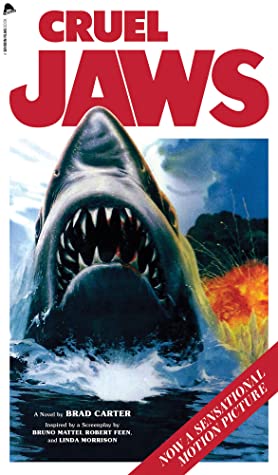 perfunctory and nonsensical of the many JAWS wannabes (no small claim!).
perfunctory and nonsensical of the many JAWS wannabes (no small claim!).
What’s surprising about this novel is that, contrary to what I was expecting, it’s an extremely slick and professionally drafted piece of work. The screenplay it transposes, about a monster shark threatening a seaside resort, is completely ridiculous, but Brad Carter succeeds in creating a gungy yet satisfying sex-and-gore packed account that ranks quite favorably with the novels of the “nasties” school of horror writing.
Where Carter doesn’t succeed is in overcoming the inherently derivative nature of the material. It’s no accident that the story was blatantly copied from that of JAWS (both the film and Peter Benchley source novel), and that’s painfully evident throughout CRUEL JAWS, which if it weren’t a novelization would probably inspire a plagiarism lawsuit by Universal Pictures. It might still.
Looking Forward…
THE CITY OF UNSPEAKABLE FEAR by JEAN RAY
An early 1940s novel that “plays at the margins of the ghost story and the detective novel” from Jean Ray, of the above-profiled MALPERTUIS.
DEAD SILENCE by S.A. BARNES
From the press release: “This epic space thriller that meshes ALIEN with EVENT HORIZON has had incredible buzz and will have readers on the edge of the captain’s chairs.”
THE GREEN HAND AND OTHER STORIES by NICOLE CLAVELOUX
A rare English language collection of comic strips by France’s Nicole Claveloux, who’s known for dreamlike whimsy. Included is an introduction by GHOST WORLD’s Daniel Clowes.
HEAT Prequel Novel (untitled) by MICHAEL MANN, DON WINSLOW
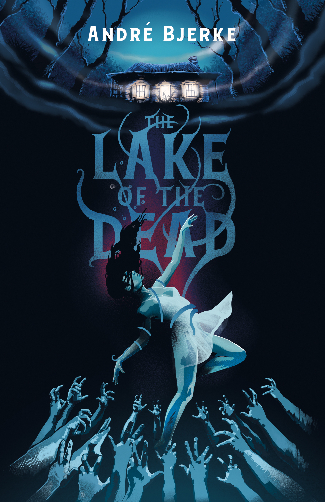 This long-in-the-works novel, initially announced back in 2017, is said to function as both a prequel and a sequel to the 1995 Michael Mann movie HEAT.
This long-in-the-works novel, initially announced back in 2017, is said to function as both a prequel and a sequel to the 1995 Michael Mann movie HEAT.
THE LAKE OF THE DEAD by ANDRE BJERKE
The premiere English translation of a 1942 novel that has been voted the all-time finest Norwegian thriller (and served as the basis of the similarly titled 1958 film).
LIARMOUTH. A FEEL-BAD ROMANCE by JOHN WATERS
A novel by trash culture guru John Waters, a “hilariously filthy tale of sex, crime, and family dysfunction.”
THE PROJECTOR AND THE ELEPHANT by MARTIN VAUGHN-JAMES
Yes! Reprints of two pioneering (and heretofore impossible-to-find) 1960s-era graphic novels by Martin Vaughn-James. Based on his surreal masterwork THE CAGE, I say this volume is a must buy.
ROBERT AICKMAN: AN ATTEMPTED BIOGRPAHY by J.B. RUSSELL
An “attempted biography” of the UK’s late Robert Aickman, one of the world’s masters of the weird tale, by J.B. Russell, an author who knows a bit about weird fiction himself.
THE TWILIGHT WORLD by WERNER HERZOG
The premiere novel by filmmaker Werner Herzog, who’s delivered a manuscript that’s said to be “part documentary, part poem, and part dream.”
